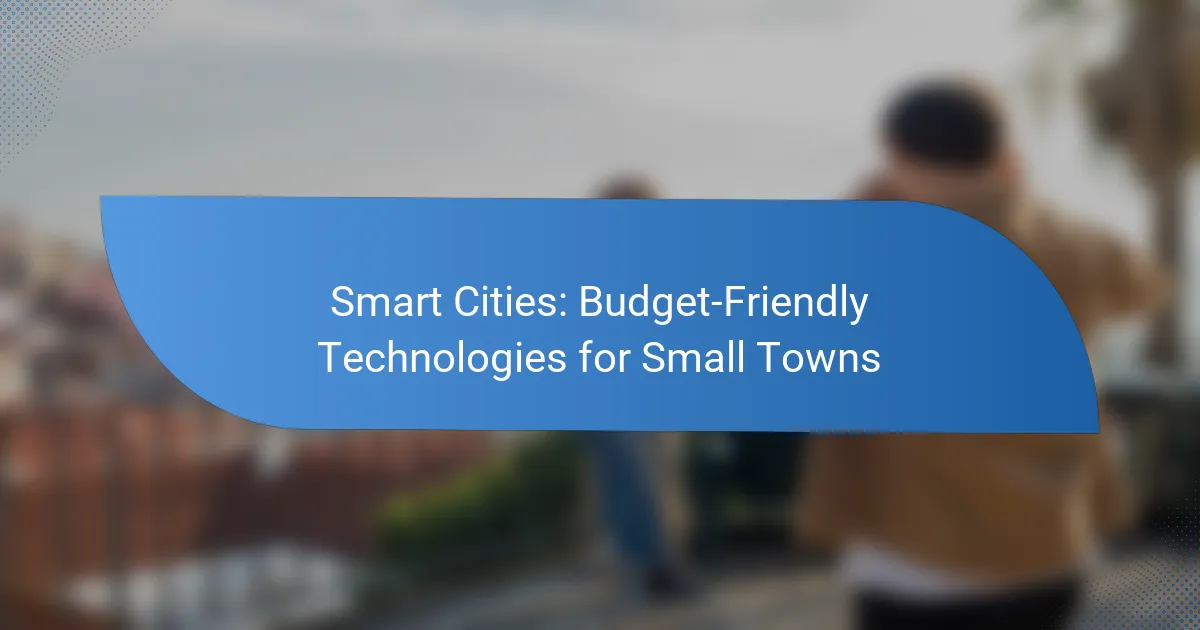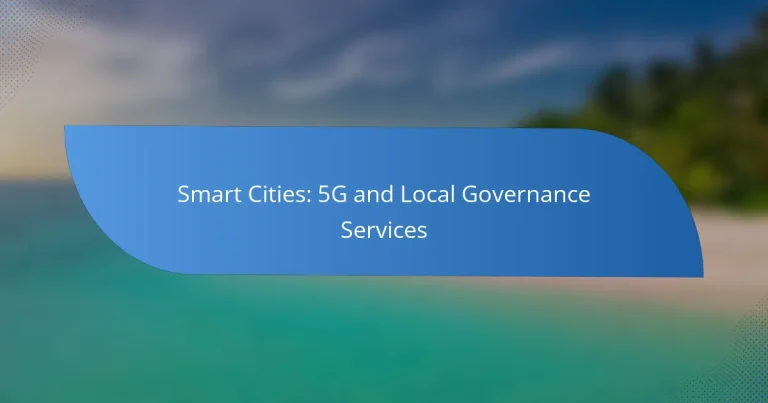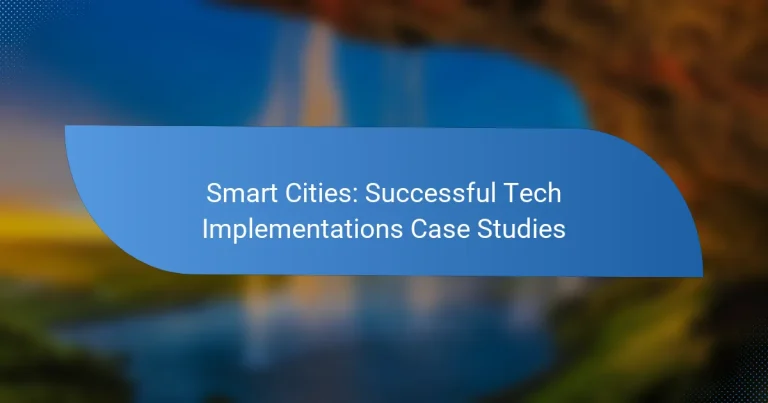Smart Cities: Budget-Friendly Technologies for Small Towns
Budget-friendly technologies for smart cities are essential for small towns looking to enhance urban living without straining their finances. By leveraging existing infrastructure and engaging the community, these towns can implement cost-effective solutions that improve efficiency and sustainability. Ultimately, smart technologies not only optimize resource use but also lead to long-term savings and better service delivery.

What Are the Best Budget-Friendly Technologies for Smart Cities?
Budget-friendly technologies for smart cities focus on enhancing urban living while minimizing costs. These solutions often leverage existing infrastructure and are designed to improve efficiency and sustainability in small towns.
IoT Sensors for Traffic Management
IoT sensors can significantly enhance traffic management by monitoring vehicle flow and congestion in real-time. These devices collect data that can be analyzed to optimize traffic signals and reduce delays, leading to smoother commutes.
Small towns can implement low-cost sensors at key intersections and along busy roads. The data gathered can help local authorities make informed decisions about road improvements and traffic patterns.
Smart Street Lighting Systems
Smart street lighting systems use LED technology combined with sensors to adjust brightness based on pedestrian and vehicle presence. This not only saves energy but also improves safety in public spaces.
For small towns, retrofitting existing streetlights with smart controls can be a cost-effective solution. These systems can reduce energy costs by up to 50%, making them an attractive option for budget-conscious municipalities.
Public Wi-Fi Solutions
Implementing public Wi-Fi can enhance connectivity for residents and visitors, supporting local businesses and community engagement. Affordable solutions often involve partnerships with local internet service providers to extend coverage.
Small towns should consider installing Wi-Fi hotspots in public areas like parks and town squares. This can foster a sense of community and attract tourists, ultimately benefiting the local economy.
Waste Management Technologies
Waste management technologies, such as smart bins equipped with sensors, can optimize collection routes and schedules. These systems alert waste management services when bins are full, reducing unnecessary pickups and saving fuel costs.
By adopting these technologies, small towns can improve their waste management efficiency and reduce operational costs. Implementing a pilot program with a few smart bins can help gauge effectiveness before a wider rollout.
Energy-Efficient Buildings
Energy-efficient buildings utilize technologies such as smart thermostats and energy management systems to reduce energy consumption. These solutions can lead to significant savings on utility bills for both public and private structures.
Small towns can encourage energy-efficient upgrades through incentives or grants for retrofitting existing buildings. Promoting energy efficiency not only lowers costs but also contributes to environmental sustainability, aligning with smart city goals.
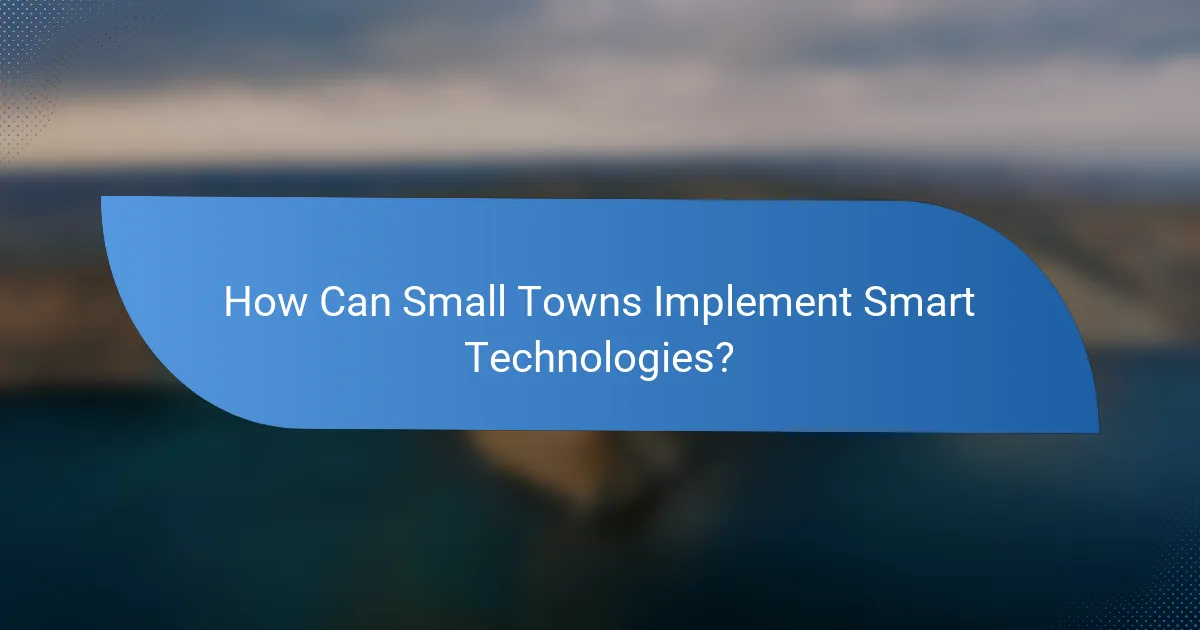
How Can Small Towns Implement Smart Technologies?
Small towns can implement smart technologies by leveraging partnerships, securing funding, and engaging the community. These strategies help to integrate cost-effective solutions that enhance urban living and improve resource management.
Partnerships with Tech Companies
Forming partnerships with technology companies can provide small towns access to innovative solutions without the high upfront costs. Collaborations can include pilot programs where tech firms test their products in real-world settings, often at reduced rates.
For example, a small town might partner with a local startup to install smart streetlights that adjust brightness based on traffic. This not only saves energy but also demonstrates the town’s commitment to sustainability.
Government Grants and Funding
Many governments offer grants and funding opportunities specifically aimed at supporting smart city initiatives. Small towns should research available programs at both state and federal levels, which can cover a significant portion of project costs.
For instance, in the United States, the Smart Cities Challenge provides funding for innovative projects that improve urban infrastructure. Small towns can apply for these grants to finance technologies like smart waste management systems or enhanced public transportation options.
Community Engagement Initiatives
Engaging the community is crucial for the successful implementation of smart technologies. Towns should involve residents in the planning process to ensure that the solutions meet their needs and gain public support.
Hosting workshops or surveys can help gather input on what technologies residents find most beneficial. For example, a town might discover that residents prioritize improved internet access over smart parking solutions, guiding their investment decisions.
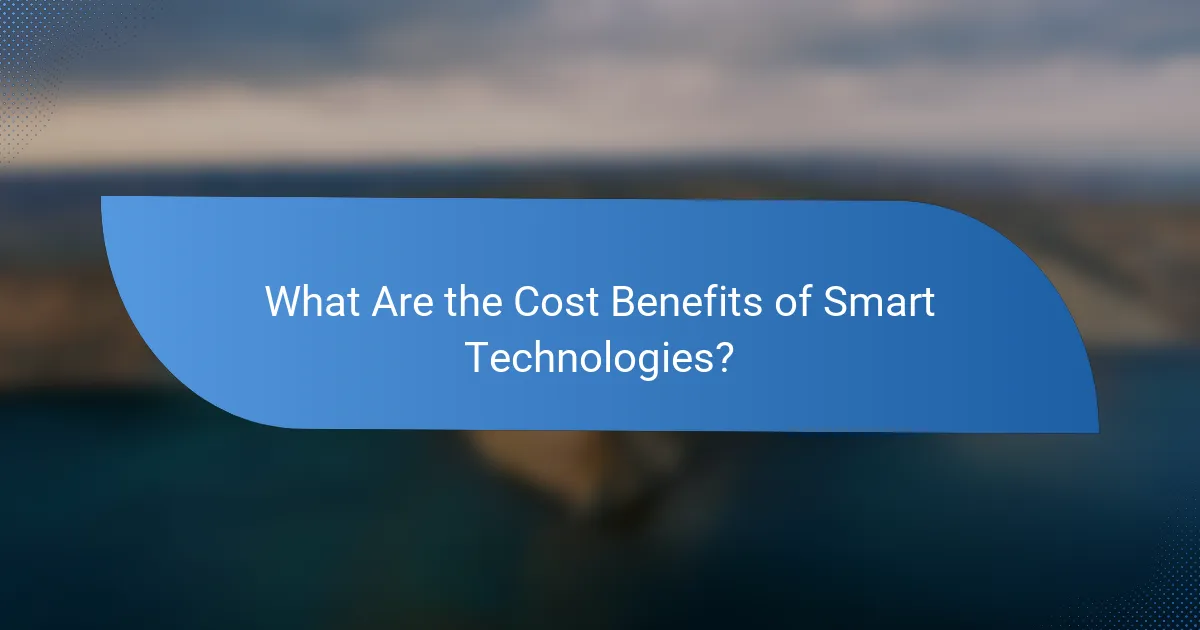
What Are the Cost Benefits of Smart Technologies?
Smart technologies offer significant cost benefits for small towns by optimizing resource use and improving service delivery. These technologies can lead to long-term savings through reduced expenses and enhanced operational efficiency.
Reduced Operational Costs
Implementing smart technologies can lower operational costs by automating routine tasks and streamlining processes. For instance, smart waste management systems can optimize collection routes, reducing fuel costs and labor hours.
Small towns can also benefit from predictive maintenance in public infrastructure, which minimizes unexpected repairs and extends the lifespan of assets. This proactive approach can save municipalities thousands of dollars annually.
Increased Energy Efficiency
Smart technologies contribute to increased energy efficiency by enabling better monitoring and control of energy consumption. For example, smart streetlights can adjust brightness based on real-time conditions, leading to significant reductions in electricity usage.
Additionally, towns can implement smart grids that allow for real-time energy management, helping to lower costs and reduce peak demand. This can be particularly beneficial in regions where energy prices fluctuate significantly throughout the day.
Enhanced Public Services
Smart technologies enhance public services by improving responsiveness and accessibility. For example, smart traffic management systems can reduce congestion and improve travel times, benefiting both residents and local businesses.
Moreover, digital platforms for citizen engagement can streamline communication between residents and local governments, leading to quicker resolutions of issues and better allocation of resources. This not only enhances service delivery but also fosters community involvement.
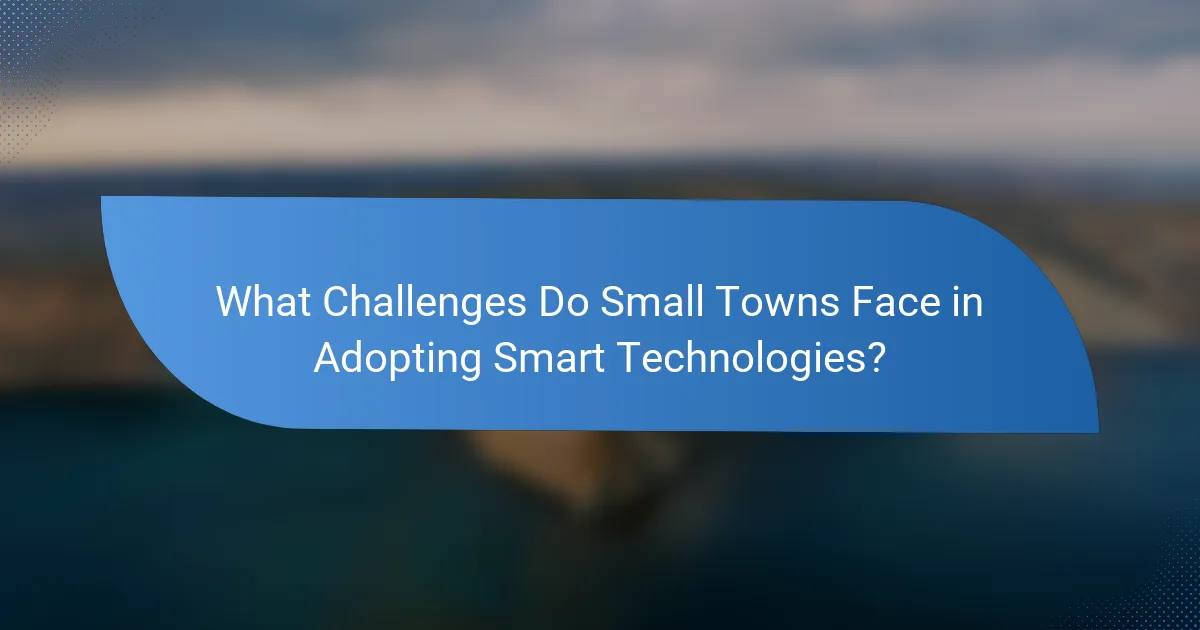
What Challenges Do Small Towns Face in Adopting Smart Technologies?
Small towns often encounter several challenges when adopting smart technologies, including financial constraints, a shortage of technical skills, and resistance from the community. These hurdles can hinder the effective implementation of innovative solutions that could enhance local services and infrastructure.
Limited Budgets
Many small towns operate on tight budgets, making it difficult to allocate funds for smart technology initiatives. The costs associated with purchasing, implementing, and maintaining these technologies can be significant, often requiring careful financial planning and prioritization.
To address budget limitations, towns can explore grant opportunities, partnerships with private companies, or collaborative projects with neighboring municipalities. These strategies can help share costs and resources, making smart technology adoption more feasible.
Lack of Technical Expertise
Small towns frequently lack the technical expertise needed to implement and manage smart technologies effectively. This gap can lead to challenges in selecting appropriate solutions, integrating systems, and troubleshooting issues that arise.
Investing in training for existing staff or collaborating with local universities and tech organizations can help bridge this knowledge gap. Additionally, towns might consider hiring consultants or forming advisory committees to guide technology adoption.
Resistance to Change
Community resistance can be a significant barrier to adopting smart technologies in small towns. Residents may be skeptical about the benefits or concerned about privacy and data security issues associated with new technologies.
To overcome resistance, it is essential to engage the community through informational sessions, surveys, and open forums. Demonstrating the tangible benefits of smart technologies, such as improved public safety or enhanced service delivery, can help build trust and support for these initiatives.

What Criteria Should Small Towns Consider When Choosing Technologies?
Small towns should prioritize affordability, scalability, and ease of implementation when selecting technologies. These factors ensure that the solutions can grow with the community’s needs while remaining budget-friendly and straightforward to adopt.
Scalability of Solutions
Scalability refers to a technology’s ability to adapt and grow as the town’s population and needs change. Small towns should look for solutions that can be easily expanded or upgraded without requiring a complete overhaul. For example, a modular smart lighting system can start with a few units and expand as budget allows.
Consider technologies that integrate well with existing infrastructure. This reduces costs and simplifies the process of scaling up. A good rule of thumb is to choose systems that offer cloud-based management, as they often provide easier updates and expansions.
Ease of Implementation
Technologies should be straightforward to implement, requiring minimal disruption to daily life. Small towns should evaluate the training and support offered by vendors, as well as the time needed for installation. Solutions that can be deployed quickly, such as mobile apps for community engagement, are often more appealing.
It’s beneficial to choose technologies that local staff can manage without extensive training. This not only saves costs but also empowers the community. A checklist for ease of implementation might include vendor support, user-friendliness, and integration with current systems.
Long-Term Sustainability
Long-term sustainability involves ensuring that the chosen technologies are not only environmentally friendly but also economically viable over time. Small towns should assess the total cost of ownership, including maintenance and operational expenses. For instance, solar-powered streetlights may have higher upfront costs but lead to significant savings in energy bills.
Additionally, consider technologies that comply with local environmental regulations and contribute to sustainability goals. A practical approach is to evaluate the lifespan of the technology and its impact on the community, ensuring that it aligns with long-term planning efforts.
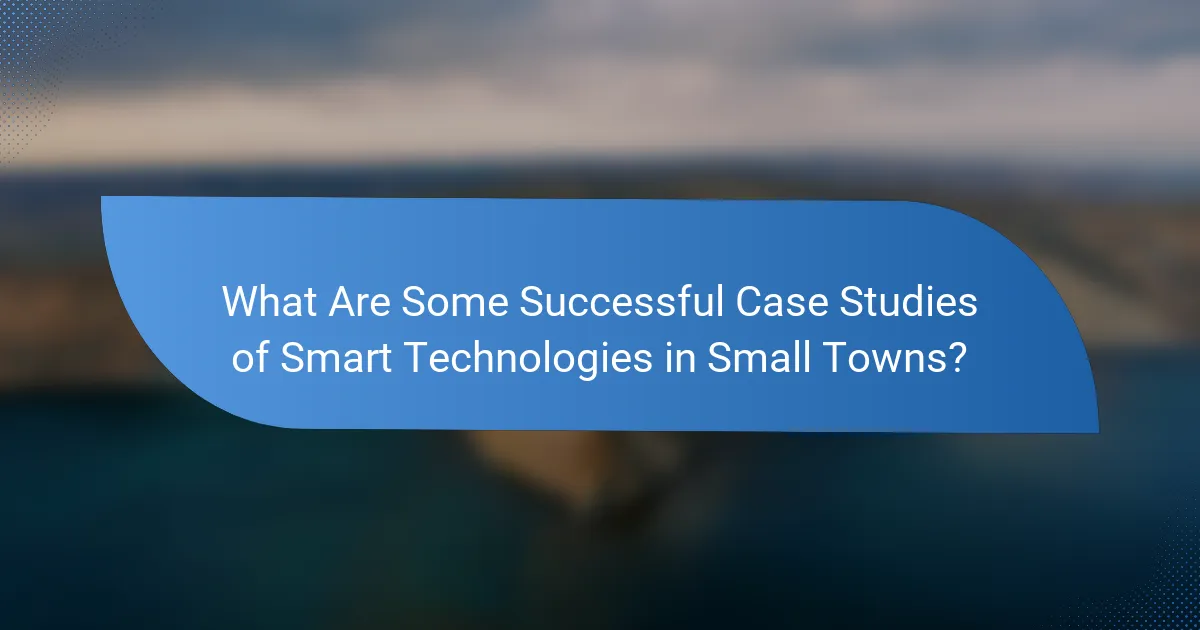
What Are Some Successful Case Studies of Smart Technologies in Small Towns?
Several small towns have successfully implemented smart technologies to enhance efficiency and improve quality of life. These case studies highlight practical applications that are budget-friendly and adaptable for similar communities.
Example: Smart Lighting in Springfield
Springfield has adopted smart lighting systems that adjust brightness based on real-time data, significantly reducing energy costs. The system uses sensors to detect movement and ambient light, ensuring that lights are only on when needed.
This technology has led to energy savings of around 30-50%, depending on usage patterns. Additionally, the town can monitor and manage lighting remotely, allowing for quick repairs and maintenance.
For small towns considering similar implementations, investing in LED fixtures combined with smart controls can yield substantial savings and enhance public safety at night.
Example: Waste Management in Montpelier
Montpelier has introduced smart waste bins that monitor fill levels and optimize collection routes. These bins use sensors to notify waste management services when they are nearly full, reducing unnecessary pickups.
This approach has cut collection costs by approximately 20-30% and decreased greenhouse gas emissions from collection vehicles. The town has also improved cleanliness and reduced overflow issues in public areas.
Small towns can benefit from such systems by investing in IoT-enabled bins, which can be integrated with existing waste management software for seamless operation.
Example: Traffic Management in Ashland
Ashland implemented a smart traffic management system that utilizes real-time data to optimize traffic flow and reduce congestion. The system adjusts traffic signals based on current traffic conditions, improving travel times for residents.
By using this technology, Ashland has seen a reduction in average wait times at intersections by about 10-15%. The system also provides valuable data for future urban planning and infrastructure improvements.
For small towns, investing in adaptive traffic signals can enhance mobility and improve the overall driving experience, especially in areas with growing populations.
